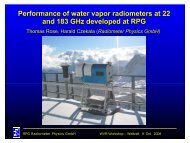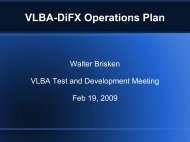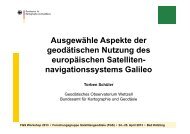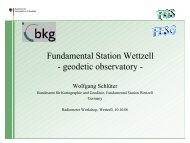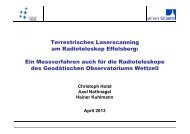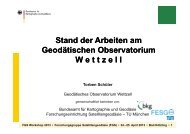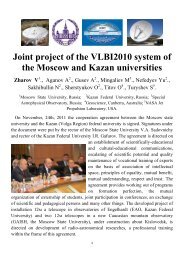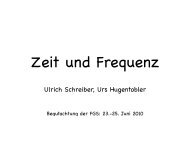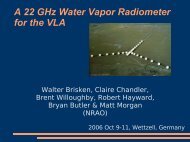GRACE-A and GRACE-B together
GRACE-A and GRACE-B together
GRACE-A and GRACE-B together
Create successful ePaper yourself
Turn your PDF publications into a flip-book with our unique Google optimized e-Paper software.
Conclusions<br />
• 1-2 cm kinematic positioning for LEO satellites <strong>and</strong> IGS stations &<br />
10 cm for GPS satellites is possible.<br />
• Kinematic POD can be used as an interface for determination of gravity field<br />
parameters <strong>and</strong> other phenomenon that govern the satellite motion.<br />
• 30-s GPS satellite clocks can be estimated with the full normal equation matrix using 40<br />
IGS stations. Positioning with the relative phase clocks has been successfuly performed.<br />
• 90%-100% of all ambiguities can be resolved for <strong>GRACE</strong> baseline using Melbourne-<br />
Wübbena wide-lanning with narrow-lane bootstrapping.<br />
• After ambiguity resolution kinematic <strong>and</strong> reduced-dynamic baseline results agree on<br />
the level of 1 cm <strong>and</strong> 3 mm respectively when validated with KBR measurements.<br />
• Combined processing of zero- <strong>and</strong> double-differences changes the orbit by 1-2 cm<br />
compared to zero-diff. case <strong>and</strong> is the optimal strategy for the LEO formation flying.<br />
• KBR <strong>and</strong> ambiguity resolution clearly shows colored noise in the kinematic positions<br />
<strong>and</strong> defficienties in the dynamic modelling.<br />
• KBR has very strong impact on the kinematic <strong>and</strong> reduced-dynamic GPS baseline<br />
even when the ambiguities are fixed.<br />
FGS Workshop 2004, Höllenstein/Wettzell, October 27 - 29, 2004





